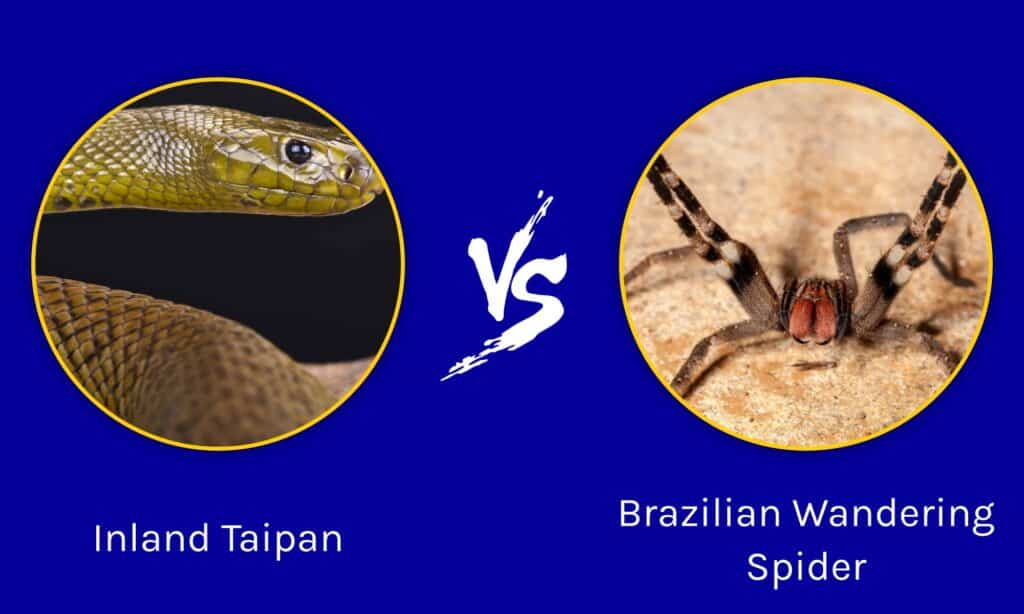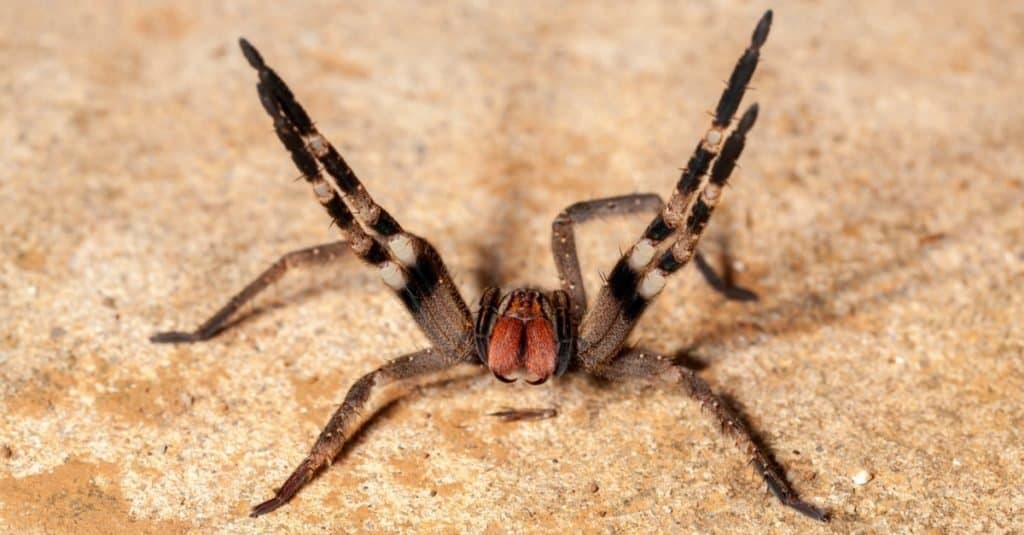The inland taipan is recognized for having the deadliest venom of any land snake in the world. This snake injects enough venom in its victims to kill upwards of 289 human beings. Yet, we would be wrong if we don’t mention other animals with deadly venom. For example, the Brazilian wandering spider is an arthropod from South America that may just have the deadliest venom of any spider, despite not being the deadliest spider in the world. Today, we will examine the inland taipan vs Brazilian wandering spider and show you which of them is more deadly.
Just for clarification, since the name Brazilian wandering spider has been applied to a few other spiders, like the banana spider, the genus we’re examining is the venomous Phoneutria. Please take a look at the different facets of these animals and learn what makes them so deadly.
Comparing an Inland Taipan and a Brazilian Wandering Spider

| Inland Taipan | Brazilian Wandering Spider | |
|---|---|---|
| Size | – Weight: 3lbs-4.4lbs – Length: 4ft-6ft, up to 9ft maximum | – Length: 5in-7in including legs – Body length 0.6in-1.8in |
| Venom Potency | – 44mg average venom load with 110mg maximum – Capable of killing between 100 and 280 humans with a single bite – LD50 of 0.025mg/kg – Believed to have the deadliest land snake venom – Can cause catastrophic effects in humans in less than an hour | – Can cause respiratory arrest, sweating, vomiting, and paralysis – May inject 0.4mg to 1.2mg of venom per bite – LD50 of 0.006mg/kg – Can kill a person in an hour without treatment – Antivenom exists to prevent deaths |
| Venom Delivery System | – Uses hollowed fangs to bite creatures and envenomate them | – Venomous fangs |
| Envenomation Level | – Nearly 100% envenomation rate and delivers several bites | – Estimated to deliver venom in 33% of bites |
| Aggressiveness | – A skittish snake – Prefers to avoid confrontations with humans; thus, interactions are rare. | – Highly aggressive spider – Often wanders the jungle floor and hides in populated areas such as plants, clothes, and woodpiles |
| Number of Fatalities Per Year | – No confirmed fatalities due to the remoteness of the snake | – Only 15 deaths since 1903 – 0.5% of bites are severe – 4,000 bites per year |
The Key Differences Between an Inland Taipan vs Brazilian Wandering Spider

The Brazilian wandering Spiders’ venom is a powerful weapon.
©Tacio Philip Sansonovski/Shutterstock.com
The most significant differences between an inland taipan and a Brazilian wandering spider include morphology, aggression, and range.
The inland taipan is a carnivorous snake found in the interior deserts of Australia that is known for actively avoiding contact with humans, while the Brazilian wandering spider is an eight-legged arthropod that lives in the tropical forests of South America and is known for being aggressive.
These are the most prominent differences between the inland taipan and the Brazilian wandering spider. Now, we will delve into what makes them each so deadly and compare the animals based on the amount of harm they can cause.
Inland Taipan vs Brazilian Wandering Spider: Size
The inland taipan is bigger than the Brazilian wandering spider. The snake can grow up to 9ft long and weigh 4.4lbs. The weight of the Brazilian wandering spider is much less than 1lb, but they can grow 7in, including their leg length.
Inland Taipan vs Brazilian Wandering Spider: Venom Potency
The inland taipan has more powerful venom than the Brazilian wandering spider. The snake delivers anywhere between 44mg and 110mg of venom, but the LD50 (a measure of venom potency) of the snake is 0.025mg/kg. In other words, this snake has enough venom to kill 280 humans with a single bite, causing death in less than an hour.
The Brazilian wandering spider has an LD50 of 0.0006mg/kg, but it only has 0.4mg to1.2mg of venom to deliver in its entire body. Thus, the sheer amount of venom that the inland taipan produces allows it to be far more potent than the spider.
Fortunately, antivenoms exist for both venoms, reducing the number of deaths.
Inland Taipan vs Brazilian Wandering Spider: Venom Delivery System
The inland taipan and the Brazilian wandering spider use fangs to envenomate their prey. The inland taipan has longer fangs than the spider and is better-suited to envenomate a mammal.
Inland Taipan vs Brazilian Wandering Spider: Envenomation
The inland taipan is believed to envenomate its prey 100% of the time. Every bite is loaded with deadly venom. However, the Brazilian wandering spider is believed only to envenomate its foes about 33% of the time. They often issue dry bites to scare off larger creatures.
That is a significant factor in determining which of the two animals is more deadly.
Inland Taipan vs Brazilian Wandering Spider: Aggressiveness
The inland taipan is a very placid creature, but the Brazilian wandering spider is known for being very aggressive. The Brazilian wandering spider will often hide during the day and wander the forest floors at night searching for prey. When people happen across them, the spiders respond by biting and envenomating them. While the spiders don’t “hunt” humans, they will bite before they retreat.
Inland Taipan vs Brazilian Wandering Spider: Fatalities Per Year
A fatal bite by an inland taipan has never been recorded. This snake lives far away from people and will slither away to prevent a confrontation. Moreover, the prevalence of antivenom makes surviving a bite more possible.
Only 15 deaths have been attributed to the Brazilian wandering spiders since 1903. The spiders bite about 4,000 people per year, and less than 0.5% of all bites are medically significant. With such low amounts of venom, difficulty penetrating human clothes and skin, and antivenom, most people make a full recovery.
Inland Taipan vs Brazilian Wandering Spider: Which Is More Deadly?

Inland Taipan (Oxyuranus microlepidotus) is one of the world’s most venomous snake species.
©reptiles4all/Shutterstock.com
The inland taipan is more deadly than the Brazilian wandering spider. The Brazilian wandering spider bites many people each year, but it kills practically none. Since we can’t look at which one kills more people, we have to determine which one is more deadly by potential.
Instead, we must look at which creature would be most problematic if humans encountered them. In this case, the inland taipan is more deadly. The snake envenomates its prey all the time, but the spider does not. The inland taipan has a better chance of landing a bite, too. Furthermore, the snake has deadlier venom and more of it than the spider.
In short, a human envenomated by the snake would be in far more peril than someone bitten by the spider. Even if a human got the antivenom in time in both cases, the higher mortality rate would be seen in the inland taipan.
Humans’ only advantage is that inland taipan lives in a very remote and hospitable habitat.
The photo featured at the top of this post is © Ken Griffiths/Shutterstock.com
Thank you for reading! Have some feedback for us? Contact the AZ Animals editorial team.






